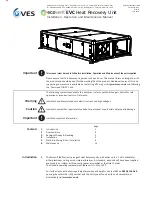
1-4
SLICE EXOTHERMIC CUTTING EQUIPMENT
89250848
surrounding area. Skin should be protected from arc rays, heat, and molten metal. Always wear protective
gloves and clothing. All pockets should be closed and cuffs sewn shut. Leather aprons, sleeves, leggings,
etc. should be worn for out-of-position welding and cutting, or for heavy operations using large electrodes.
Hightop work shoes provide adequate protection from foot burns. For added protection, use leather spats.
Flammable hair preparations should not be used when welding/cutting. Wear ear plugs to protect ears
from sparks. Where work permits, the operator should be enclosed in an individual booth painted with a
low reflective material such as zinc oxide.
See safety and operating references 1, 2, and 3.
WELDING SPARKS CAN CAUSE FIRES AND EXPLOSIONS
Combustibles reached by the arc, flame, flying sparks, hot slag, and heated materials can
cause fire and explosions. Remove combustibles from the work area and/or provide a fire
watch. Avoid oily or greasy clothing as a spark may ignite them. Have a fire extinguisher
nearby, and know how to use it. If welding/cutting is to be done on a metal wall, partition,
ceiling, or roof, precautions must be taken to prevent ignition of nearby combustibles on the other side. Do
not weld/cut containers that have held combustibles. All hollow spaces, cavities, and containers should be
vented prior to welding/cutting to permit the escape of air or gases. Purging with inert gas is recommend-
ed.
Never
use oxygen in a welding torch. Use only inert gases or inert gas mixes as required by the
process. Use of combustible compressed gases can cause explosions resulting in personal injury or death.
Arcing against any compressed gas cylinder can cause cylinder damage or explosion.
See safety and
operating references 1, 2, 5, 7, and 8.
NOISE CAN DAMAGE HEARING
Noise from the air carbon-arc process can damage your hearing. Wear protective hearing
devices to ensure protection when noise levels exceed OHSA standards. Adequate hearing
protection devices must be worn by operators and surrounding personnel to ensure personal
protection against noise.
See safety and operating references 1, 2, and 6.
SAFETY AND OPERATING REFERENCES
1. Code of Federal Regulations (OSHA) Section 29, Part 1910.95, 132, 133, 134, 139, 251, 252, 253,
254 and 1000. U.S. Government Printing Office, Washington, DC 20402.
2. ANSI Z49.1 “Safety in Welding and Cutting”.
3. ANSI Z87.1 “Practice for Occupational and Educational Eye and Face Protection”.
4. ANSI Z88.2. “Standard Practice for Respiratory Protection”. American National Standards Institute,
1430 Broadway, New York, NY 10018.
5. AWS F4.1. “Recommended Safe Practices for Welding and Cutting Containers”.
6. AWS C5.3. “Recommended Practices for Air Carbon-Arc Gouging and Cutting”. The American
Welding Society, 550 NW Lejeune Rd., P.O. Box 351040, Miami, FL 33135.
7. NFPA 51B. “Fire Prevention in Cutting and Welding Processes”.
8. NFPA-7. “National Electrical Code”. National Fire Protection Association, Battery Park, Quincy, MA
02269.
9. CSA W117.2. “Safety in Welding, Cutting and Allied Processes”. Canadian Standards Association,
178 Rexdale Blvd., Rexdale, Ontario, Canada M9W 1R3.
SAFETY
Содержание SLICE PACKAGE
Страница 12: ...3 2 SLICE EXOTHERMIC CUTTING EQUIPMENT 89250848 PROCESS FUNDAMENTALS This Page Intentionally Blank...
Страница 16: ...4 4 SLICE EXOTHERMIC CUTTING EQUIPMENT 89250848 This Page Intentionally Blank EQUIPMENT...
Страница 26: ...8 2 SLICE EXOTHERMIC CUTTING EQUIPMENT 89250848 This Page Intentionally Blank APPLICATIONS...
Страница 28: ...9 2 SLICE EXOTHERMIC CUTTING EQUIPMENT 89250848 This Page Intentionally Blank TROUBLESHOOTING...
Страница 33: ......









































